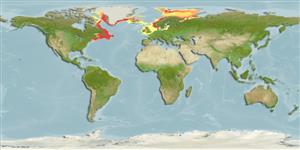Common names from other countries
Environment: milieu / climate zone / depth range / distribution range
Ecologia
marino demersale; oceanodromo (Ref. 51243); distribuzione batimetrica 25 - 600 m (Ref. 35388), usually 100 - 400 m. Temperate; 81°N - 42°N, 71°W - 59°E
Northwest Atlantic: western Greenland and Nova Scotia in Canada to Massachusetts in USA and perhaps to New Jersey, USA (Ref. 7251). Northeast Atlantic: Spitsbergen southward to Scandinavian coasts (to about Bergen, also Iceland and south-eastern coasts of Greenland.
Length at first maturity / Size / Peso / Age
Maturity: Lm 55.0, range 50 - 60 cm
Max length : 180 cm TL maschio/sesso non determinato; (Ref. 7251); common length : 120 cm TL maschio/sesso non determinato; (Ref. 4694); peso massimo pubblicato: 27.9 kg (Ref. 40637)
Coloration greyish brown with many distinct spots on body and dorsal fin (Ref. 35388).
Inhabits offshore waters over soft bottoms, often with boulders, from 25-590 m, but most common from 100-400 m (Ref. 4694). Benthic (Ref. 58426). Feeds mainly on echinoderms, but also crustaceans, mollusks, fishes (Ref. 4694) and worms (Ref. 58426). In Barents sea, it reached at least 80 cm, age 9 years. Marketed fresh or as frozen fillets. Leather can be made of the skin (Ref. 35388).
Spawning happens between the months of September and January at 250 m depth. Females lay great egg bunches in nests built on the ground. The size of the eggs increases with the size of the female. Egg size 5-6 mm, larval length at hatching 21-24 mm.
Barsukov, V.V., 1986. Anarhichadidae. p. 1113-1116. In P.J.P. Whitehead, M.-L. Bauchot, J.-C. Hureau, J. Nielsen and E. Tortonese (eds.) Fishes of the North-eastern Atlantic and the Mediterranean. volume 3. UNESCO, Paris. (Ref. 4694)
IUCN Red List Status (Ref. 130435)
CITES (Ref. 128078)
Not Evaluated
Threat to humans
Harmless
Human uses
Pesca: scarso interesse commerciale; Pesce da pesca sportiva: si
Strumenti
Special reports
Download XML
Fonti Internet
Estimates based on models
Preferred temperature (Ref.
115969): 0.6 - 7.6, mean 3.5 (based on 717 cells).
Phylogenetic diversity index (Ref.
82804): PD
50 = 0.5938 [Uniqueness, from 0.5 = low to 2.0 = high].
Bayesian length-weight: a=0.00339 (0.00183 - 0.00626), b=3.19 (3.02 - 3.36), in cm Total Length, based on LWR estimates for this species & (Sub)family-body (Ref.
93245).
Trophic level (Ref.
69278): 3.8 ±0.62 se; based on food items.
Resilienza (Ref.
120179): Basso, tempo minimo di raddoppiamento della popolazione 4.5 - 14 anni (K=0.06-0.13; tm=8; Fec=4,200-35,200).
Fishing Vulnerability (Ref.
59153): Very high vulnerability (80 of 100).
Climate Vulnerability (Ref.
125649): Moderate vulnerability (43 of 100).
